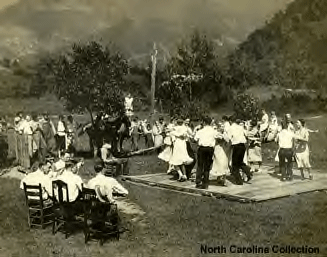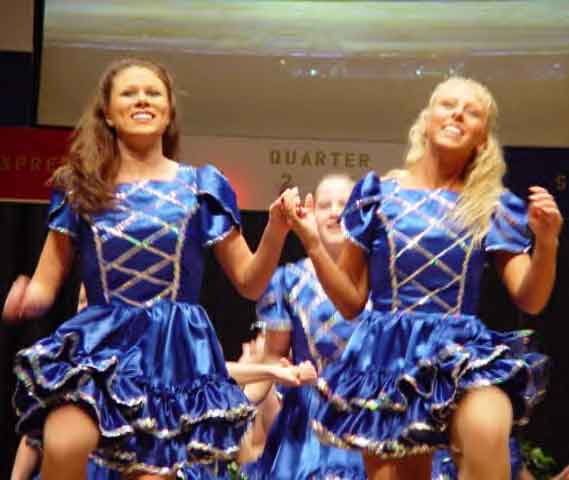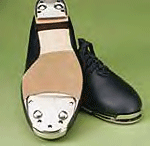 For reasons of aesthetics and presentation (and probably noise control), groups of cloggers began coordinating steps in unison, which brought a unity to the group, and standardization to the movement. “Precision” clogging, as it is called, started in the 1950’s with James Kesterton's Blue Ridge Mountain Dancers. He was one of the first to orient the dancers to face the audience, regularly institute matching costumes, and use unison footwork. His was also one of the first clogging teams to wear metal taps on their shoes, which Bascom Lamar Lunsford considered "cheating." But the innovations took and groups throughout the south copied the new trends.
For reasons of aesthetics and presentation (and probably noise control), groups of cloggers began coordinating steps in unison, which brought a unity to the group, and standardization to the movement. “Precision” clogging, as it is called, started in the 1950’s with James Kesterton's Blue Ridge Mountain Dancers. He was one of the first to orient the dancers to face the audience, regularly institute matching costumes, and use unison footwork. His was also one of the first clogging teams to wear metal taps on their shoes, which Bascom Lamar Lunsford considered "cheating." But the innovations took and groups throughout the south copied the new trends. As Americans became more mobile, and interstate highways offered the opportunity for dancers to travel from area to area to workshops and competitions, the popularity of clogging as a national activity increased. Through the 1960s and 1970s, clogging teams were featured on television shows like Hee Haw and the Lawrence Welk Show, furthering its exposure, and soon clogging clubs were organized across the country, spreading the form from its cultural heartland and opening it up to influences of mainstream pop culture.
 During the late 1970's, line dances (unison steps, no partners needed) appeared, done to prerecorded music as well as to the traditional bluegrass band. Over the next three decades, aspects of tap dancing, Canadian step dancing, Irish hard shoe, jazz, and even cheerleading and hip-hop were incorporated into the steps being performed by the best teams at competitions, spurring choreographers to constantly push the envelope for the new and the bold. Clogging competitions across the country bring together teams from East and West to vie for trophies, honors and prizes. However, the older forms of clogging are still preserved, performed and respected in many clogging communities, particularly in the southern Appalachian states.
During the late 1970's, line dances (unison steps, no partners needed) appeared, done to prerecorded music as well as to the traditional bluegrass band. Over the next three decades, aspects of tap dancing, Canadian step dancing, Irish hard shoe, jazz, and even cheerleading and hip-hop were incorporated into the steps being performed by the best teams at competitions, spurring choreographers to constantly push the envelope for the new and the bold. Clogging competitions across the country bring together teams from East and West to vie for trophies, honors and prizes. However, the older forms of clogging are still preserved, performed and respected in many clogging communities, particularly in the southern Appalachian states. In American Footworks, we pay homage to the old while excelling at the new in American clogging.

Freestyle:
;
;
Our Traditional Precision
Duet: